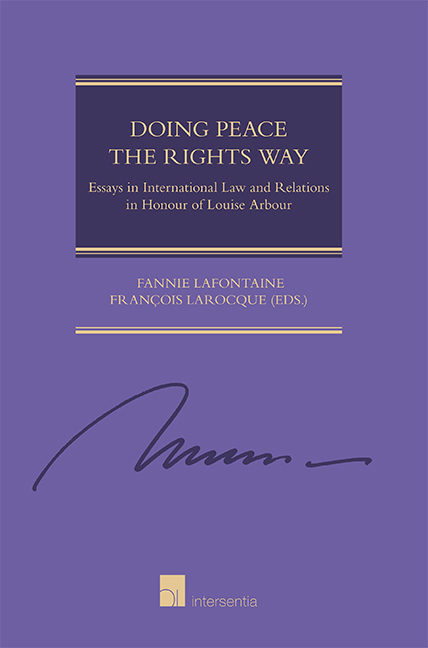Book contents
- Frontmatter
- Foreword
- Contents
- List of Contributors
- Introduction
- PART I OF FREEDOM AND EQUALITY
- PART II OF PEACE AND JUSTICE
- The Deterrence Rationale in a Criminal Justice Accountability Regime
- Peace and Justice: Human Rights Fact-Finding in Raging Conflicts
- “Exceptional Measures” in Times of Crisis: Terrorism, National Security and the Rule of Law
- When the End Lacks the Means: National Prosecutions of International Crimes and Canada's Paper Tiger Approach
- The Independence of International Prosecutors: Where Law Meets Realpolitik
- Torture, Jurisdiction and Immunity: Theories and Practices in Search of One Another
- Revisiting Challenges to International Humanitarian Law
- PART III OF WOMEN AND LEADERSHIP
- An Interview with the Honourable Madam Justice Louise Arbour
Peace and Justice: Human Rights Fact-Finding in Raging Conflicts
from PART II - OF PEACE AND JUSTICE
Published online by Cambridge University Press: 13 April 2019
- Frontmatter
- Foreword
- Contents
- List of Contributors
- Introduction
- PART I OF FREEDOM AND EQUALITY
- PART II OF PEACE AND JUSTICE
- The Deterrence Rationale in a Criminal Justice Accountability Regime
- Peace and Justice: Human Rights Fact-Finding in Raging Conflicts
- “Exceptional Measures” in Times of Crisis: Terrorism, National Security and the Rule of Law
- When the End Lacks the Means: National Prosecutions of International Crimes and Canada's Paper Tiger Approach
- The Independence of International Prosecutors: Where Law Meets Realpolitik
- Torture, Jurisdiction and Immunity: Theories and Practices in Search of One Another
- Revisiting Challenges to International Humanitarian Law
- PART III OF WOMEN AND LEADERSHIP
- An Interview with the Honourable Madam Justice Louise Arbour
Summary
INTRODUCTION
Louise Arbour began her term as High Commissioner on 1 July 2004 at a difficult time for human rights in general and for the Office of the United Nations High Commissioner for Human Rights (OHCHR) in particular. The tense international atmosphere following the terrorist attacks on the United States on 11 September 2001 was still at its peak. Armed conflicts in Afghanistan and Iraq were ongoing. Guantanamo was being filled by detainees and the relevance of international law was being questioned. Darfur was undergoing a slow but steady deadly conflict that started to gain international attention. The United Nations (UN) system was affected by the debate on the legality of the Iraq war and the Oil for Food corruption allegations. Moreover, there were public campaigns against the UN human rights system accusing it of bias and partiality.
Only ten months before Arbour took the helm, the OHCHR had been devastated by the killing of the UN High Commissioner for Human Rights S é rgio Vieira de Mello and 21 others in a terrorist attack on the Canal Hotel in Baghdad, which also left many injured, including OHCHR staff. Shocked and shaken, the OHCHR in particular and the UN human rights system in general needed a strong intellectual and strategic leader to steer the ship into safe waters. And that was Louise Arbour.
With her background as a distinguished jurist, judge and international prosecutor, Arbour focused her efforts on bringing back faith in human rights as a legal regime and the absolute need for its implementation. Factfinding was central to her approach, believing that ascertaining facts is an indispensable prerequisite to bringing respect for the rule of law. She invested in developing accountability processes that could be carried out according to a fair, credible and predictable methodology.
This chapter will narrate the story of fact-finding, largely within the UN human rights context. Aft er discussing the approaches and types of factfinding, it will examine some challenges that face fact-finding in the human rights field. The specific role of Louise Arbour will be situated in this story, particularly the strategies she developed to address some of the dilemmas that were faced.
- Type
- Chapter
- Information
- Doing Peace the Rights WayEssays in International Law and Relations in Honour of Louise Arbour, pp. 171 - 198Publisher: IntersentiaPrint publication year: 2019



